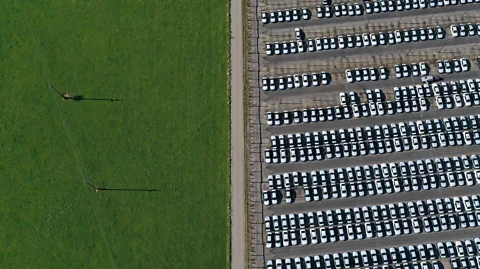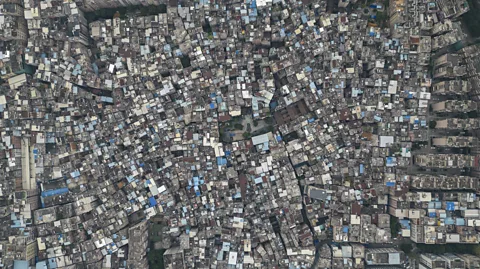What will China's population drop mean for the world?
 Getty Images
Getty ImagesBBC Future answers five key questions about China's recent population decline and what it might mean for global demographic trends.
At midnight on 1 July 1982, China began a mammoth undertaking. The goal: to find out how many people there were in the country at that exact moment in time. No one had checked since 1964, so it was anyone's guess what they would find. After years of preparations, armed with 29 computers purchased for the task – including at least 21 imported from the US under a special exemption – and five million trained personnel, they would spend the coming months diligently counting the members of every household in the country.
By October that same year, the results were in: the New York Times ran the headline "CHINA, POP. 1,008,175,288: ONE-FOURTH OF THE WORLD". Decades of growth had raised the country's population to the staggering new threshold of a billion people. A baby was born there every two seconds.
China's one-child policy was introduced in 1980, with the explicit objective of reducing population growth to zero. But though it ran for another 36 years until 2016, it is only now that China has entered "negative growth" – its numbers have started shrinking for the first time in 60 years. According to data released by China's National Bureau of Statistics, the nation was home to 1.4118 billion people in 2022, which is 850,000 fewer than there were in 2021. It reflects a decline in the country's birth rate, which has been falling over the past six years to reach a record low of 6.77 births per 1,000 people.
The change has been met with both alarm and optimism – including concerns about what this means for the global economy, and the hope that continued prosperity might not be as dependent on having a growing population as has historically been assumed. The charity Population Matters has suggested that China's stabilising numbers should be celebrated for their potential environmental benefits and the welfare of the country's citizens.
But such a stark demographic shift in the world's most populous country raises many uncertainties and implications for the future. Is China's newly declining population really a surprise? And how will it affect the planet? BBC Future looks at five of the big questions to get to grips with this story.
Why has it taken so long for China's population to shrink?
In 1991, within just a few years of the one-child policy kicking in, China's birth rate had fallen to below replacement level. Each woman was having fewer children than the number required to maintain the population size from one generation to the next. In most countries, this is usually around 2.1 – one for each woman, one for her partner, and an extra 0.1 to counteract those that die as infants.
 Getty Images
Getty ImagesIn the years that followed, China's continued growth wasn't because the controversial initiative had failed – it was down to a counterintuitive effect known as "demographic momentum". This explains how a population with constant levels of mortality and zero migration can continue to increase for decades, even when women are having fewer than 2.1 children.
It's all down to the time delay between births and deaths. Until recently, China's population was relatively youthful, with an average age of 35 in 2010, compared to 44.3 in Germany (now it's 38.4). At the same time, people have been living longer – in 2021, the country's life expectancy overtook that of the US. So, though the number of babies born per woman declined drastically, there were still more babies being born than there were people dying.
This has now changed, however. It's thought that the drop in fertility rates and slight increase in reported deaths during the Covid-19 pandemic may have played a role in accelerating a decline in China's absolute numbers, though it has been long anticipated.
Burning Questions
In this series, BBC Future takes a look at topical stories through the lens of the most pressing questions - the kind you'd need to ask to put a new development in context, or explain it to a friend.
Will China's drop in numbers affect predictions for the total global population?
According to the UN's World Population Prospects report for 2022, China's population was predicted to decline in 2023 – the reduction recently revealed by the country's census had been expected for some time. In fact, the shift has only come slightly early.
This milestone in China's demographics has already been factored into many projections for global population growth. Based on the expectation that the country's population would start to shrink in 2023, along with its predictions for other countries, the UN expects that the total number of humans on the planet will continue to expand, to reach 8.5 billion by 2030, and peak at 10.4 billion by 2086. This is the "medium" scenario, in which the birth rates of nations with high fertility will mellow, while those with low fertility rates will see marginal increases.
 Getty Images
Getty Images"This is happening in China now but it's not happening in the rest of the world, it won't happen on a global level for another 63 years," says Alistair Currie, head of campaigns and communications at Population Matters.
Most of the growth will happen in sub-Saharan Africa, which is projected to contribute to more than half of the population increase between now and 2050. The headcount in the region is projected to double in that time, with Nigeria taking the slot as the fourth most populated country on the planet.
According to Shuang Chen, assistant professor in the department of social policy at the London School of Economics, focusing on China's sheer numbers would be missing the point – though she acknowledges that from this perspective, the decline might be beneficial for climate change.
China was responsible for 27% of the carbon dioxide emitted into the atmosphere in 2022, and the country is currently building over half of the new coal-fired power plants on the planet.
"But what's really causing concerns socially is what that means in terms of the structure. Because things are changing really fast… societies may not have time to adapt," says Chen.
You might also like:
Which country is on track to overtake China as the most populous?
In the UN's 2022 report, it also forecast that 2023 will be the year that India eclipses its neighbour and becomes the most populated country in the world. In light of the census results, some commentators have even speculated that this may have already have happened.
India's population is expected to keep going up, rising from 1.417 billion in 2022 to 1.515 billion by 2030. This is mostly down to two factors: fertility rates have remained high, while mortality rates have gone down due to improvements in medicine. Then there's the population's age structure. India's population is around a decade younger than China's on average, so there are more people of childbearing age in total.
How does China's fertility rate compare with those of other countries?
China's fertility rate has been steadily declining since the 1990s to an all-time low of 1.28 in 2020. For comparison, there were 2.05 births per woman in India the same year, and 1.64 in the US. Even Japan, with its notoriously low birth rate and ageing population, had a fertility rate of 1.34.
 Getty Images
Getty ImagesThe steep downwards trajectory of China's reproductive power is thought to be down to a number of factors.
For one thing, there is an imbalance between men and women in China. The one-child policy left the country with a skewed sex ratio: there was a traditional preference for boys, with many girls being aborted, abandoned or even killed. In some age groups, there are now more than 11 men for every 10 women. – indicating that one in every 11 men will struggle to find a partner the same age.
Other factors are thought to include the rising cost of living, and a trend towards getting married later in life.
But there are also shifting values. Survey after survey has revealed that Chinese women now view the ideal number of children as one, two, or zero, despite the introduction of a two-child policy in 2015. These issues were compounded during the Covid-19 pandemic, when resentment about lockdowns and other restrictions led to the hashtag #wearethelastgeneration trending on social media.
Will China's population continue shrinking?
Over the past 200 years or so, many industrialised countries have undergone a "demographic transition" – after first growing at a rapid pace, their population eventually transitions from having high birth and death rates to low birth and death rates. China is considered to be a "post-transitional" society, which has already completed this cycle.
However, it's less clear what will happen next. China's fertility rates are expected to continue to decline, particularly as the population ages and there are fewer women of child-bearing age overall. But there are two big unknowns.
One is migration. China's levels of immigration are currently extremely low, but Currie explains that this could change as the country attempts to grow its economy. Then there's the possible impact of measures the government is taking to encourage citizens to reproduce. At the moment, they are not proving particularly effective, but some experts are concerned that they may adopt more coercive tactics.
"For policies to reverse the fertility decline itself is very challenging," says Chen. "In recent years China has already been coming up with lots of new measures, including getting rid of the one-child policy, some kinds of subsidies at different levels. But they haven't really been working well, fertility has not reversed. I do think this decline will continue."
--
